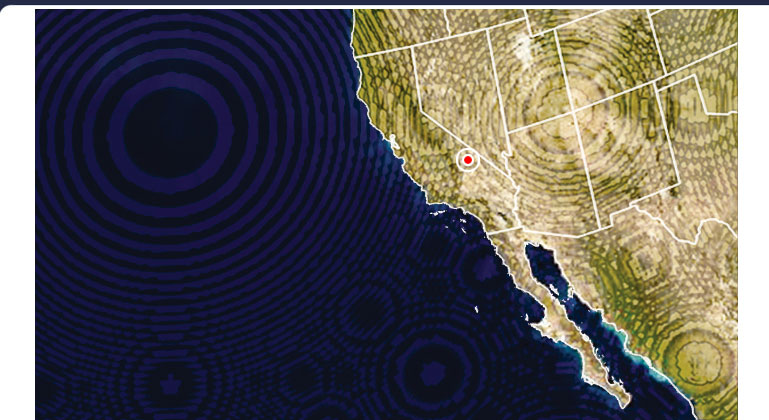




Infrasound Levitation of Piezoelectric Stones in Death Valley, California
Ice Offers Possible Explanation for Death Valley's Mysterious 'Self-Moving' Rocks
by Phillip F. Schewe for PhyOrg
Febraury 17, 2011
Death Valley National Park contains many mysteries, including one of nature's strangest phenomena: Rocks that seem to move around all on their own.
In the remote, almost totally dry lakebed called Racetrack Playa, some of the rocks move themselves across the desert floor when people aren't watching.
Scientists know the rocks move because they leave narrow tracks trailing behind them, but they haven't actually seen it happen. And although one can't entirely rule out the possibility of some prank being played, at least some of the rocks appear to be moving under natural circumstances.
It doesn't rain often in Racetrack Playa, and when it does the lakebed can flood. The rocks don't float exactly, but the main explanation for their movement is that moisture can make the mud on which the rocks sit more slick, making it easier for high winds to push the rocks along. Another explanation offered is that the temporary deposit of water, chilled to form extensive sheets of ice, might help to reflect and focus the winds, making it easier for the rocks to move.
The winds required to move rocks in this way would seem to be at the level of 100 mph or more. That's why the rocks are sometimes referred to as "sailing stones." They are rare but they have been noticed in Racetrack Playa and a few other arid places around the world subject to occasional floods.
Ralph Lorenz, a scientist at Johns Hopkins University, offers a new explanation. The rocks are actually lifted up by the ice, or at least made more buoyant by the ice, making it easier for the rocks to migrate. If the rocks are moving about on ice rafts, the ground below cannot offer as much resistance against their motion and the winds needed for movement wouldn't have to be as great, he argued.
So why hasn't the motion been observed?
"Movement happens for only tens of seconds, at intervals spaced typically by several years," said Lorenz. "This would demand exceptional patience as well as luck."
So, the rocks are probably traveling on the coldest and windiest days that occur over a period of several years. The most likely time would be in the very early dawn. Little wonder no one is around to witness the event.
Lorenz and his colleagues would like to install inexpensive time-lapse monitoring of the Playa area, using digital cameras. The lakebed is about 2.5 miles long and 1.25 miles wide. They have also performed some laboratory tests by blowing on ice-assisted rocks. These simple tests support the ice-raft hypothesis. The results appear in the January 2011 issue of the American Journal of Physics.
Analysis
There is a far more reasonable and scientifically verified explanation for this phenomenon of the 'self-moving rocks' reported above: acoustic levitation. This exact effect has been photographed and reported in other locations around the world, especially in Gushan, China, Yellowwood and Limon, Indiana State Parks, as well as in Ratria and Dhenkanal, India.
The piezoelectric properties of the quartz that is most likely the main constituent of the sandstone boulder allows its levitation by focused infrasound standing waves. The internal reflection of the parallel faces of the quartz crystals allows the acoustic energy to be stored inside the stone. The build-up of vibratory energy within the quartz lattice creates an electromagnetic field reducing the stone's weight until it becomes entirely weightless, levitating without friction along the standing wave's arch. These piezoelectric stones (identified only vaguely as 'rocks' in the article above, quite likely comprised of piezoelectric crystals like quartz and calcite) have left drag marks on the playa because of a unidirectional semi-levitation experienced during recent intense solar flare activity.
The source of the focused standing wave energy dragging these stones is the Orion pyramids at Giza, exactly 7,418 miles from the Racetrack Playa in Death Valley, California (36.681°N 117.559°W) - a distance that is exactly 29.80% of the Earth's mean circumference measurement. Such unusual acoustic semi-levitation is a sign that a new resonance is emerging in Death Valley, California, and will be building gradually into a higher energy level that has already been observed at other infrasound focal points.
Much more extreme manifestations of this resonance are waves of infrasound induced piezoelectric fires that are now simultaneously occurring in Tenerife, Babura, Lalapansi, Mapuve, Bodibe, Landovica, Longford, Messina, Peschici, Berici, across northern Greece, Ratria, Kakori, Goa, Kishtwar, Rangrik, Santo Tomas, Kota Baru, Melipilla, and in the US in Seattle, Colorado Springs, Pueblo, San Mateo, Vallejo Santa Barbara and New York City.